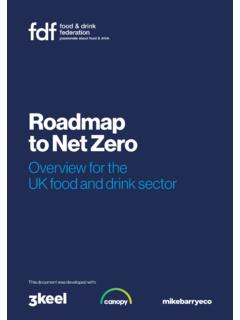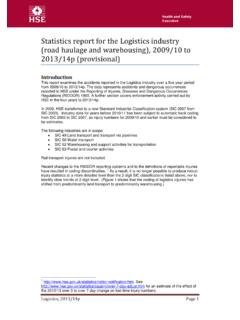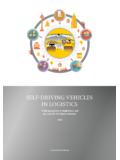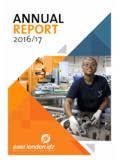Transcription of VALUE OF FOOD & DRINK MANUFACTURING TO …
1 IfM, University of CambridgeVALUE OF FOOD & DRINKMANUFACTURINGTO THE UKReport to the FDFVALUE OF FOOD & DRINKMANUFACTURING TO THE UK Copyright Institute for MANUFACTURING July 2010. All rights published in Great Britain by the University of Cambridge Institute for MANUFACTURING , 17 Charles Babbage Road, Cambridge CB3 0FS. ISBN: 978-1-902546-86-5 No part of this publication may be reproduced, stored in a retrieval system or transmitted in any form or by any means without the prior permission in writing of the publisher, nor be otherwise circulated in any form of binding or cover other than that in which it is published and without a similar condition including this condition being imposed on the subsequent 1 EXECUTIVE SUMMARYThis report provides a summary of the impact of food and DRINK manufacturers on the UK economy.
2 The MANUFACTURING element of the industry , linking the outputs of our farms to the retailers in the high street, is not well understood and so the Food and DRINK Federation (FDF) commissioned a report from the Institute for MANUFACTURING (IfM) to clarify what the impacts of the industry were and to understand what could be done to improve the economic and social impacts of the industry . Food and DRINK is a significant and resilient element of the MANUFACTURING sectorThe food and DRINK industry is a core element of the UK MANUFACTURING economy, representing over 15% of MANUFACTURING turnover and employment. Through the recent recession it was the sector that reduced its output the least and has returned to pre-recession output levels the fastest. Innovation is a key focus for the food and DRINK industryThe food and DRINK sector accounts for over 4% of the total R&D spend reported in the annual R&D Scoreboard.
3 Due to the highly competitive nature of the industry , there are over 1,500 new products introduced each quarter. This mix of product and process innovation is a core strength of the sector. The sector provides above average pay and relatively long tenure in employmentThe image of work in the food and DRINK industry is one of temporary and relatively low paid employment. Contrary to this common perception, the weekly earnings of employees in the food and DRINK industry are above those of the economy as a whole and job tenure appears to be over nine years on average for employees of food and DRINK manufacturers with only 6% temporary workers. Strong and positive response to environmental and health concerns Since 1990 food and DRINK MANUFACTURING in the UK has reduced its CO2 emissions by at least 11%, showing a strong commitment to reducing the environmental impact of food production.
4 At the same time, as there is a growing awareness of health issues related to diet and nutrition, the UK has become a leading source of new foods with health propositions. In 2007 36% of new health product launches in the European Union originated in the UK. While exports have increased significantly, imports are rising fasterOver the past decade exports of both lightly and highly processed food products have risen by approximately 15%, showing a strong demand for UK products abroad. However, there is a growing trade deficit for food and DRINK in the UK, rising from billion in 1995 to billion in 2007. This impacts on the UK s ability to increase its food independence and is an ongoing concern in terms of the environmental impact of transporting food great distances.
5 The food and DRINK sector could contribute significantly to future sustainable growth Due to its size, direct links to health outcomes and its impact on emissions from production and logistics, the food and DRINK sector should be a strategic focus of public and private action. Helping the sector to improve its trade balance, continue to invest in innovation and through supporting new low impact production technologies should be key public goals to retain a high VALUE sector with significant social and environmental impacts. Executive Summary 11. Introduction 5 Approach 5 Structure of the report 52. Structure and VALUE in food and DRINK MANUFACTURING 7 Structure of the food and DRINK industry 7 Is food and DRINK high VALUE MANUFACTURING ?
6 73. VALUE of the food and DRINK industry 11 Summary of VALUE impact 204. Future importance of the food and DRINK industry 225. Conclusion 23 Endnotes 24 Page 3 CONTENTSVALUE OF FOOD & DRINK MANUFACTURING TO THE UKBackground and structure of the projectThe impact of any one sector on the national economy is difficult to fully describe. Companies, and the industry they make up, provide jobs, invest in R&D, have a carbon footprint as well as a long list of other positives and negatives. The food and DRINK (F&D) industry is a case in point, as the real VALUE of the industry to the UK is not well understood. This report was commissioned by the Food and DRINK Federation (FDF) from the Institute for MANUFACTURING , University of Cambridge, in order to investigate the impact of the food and DRINK industry across the UK economy.
7 The starting point for the work was a sense that the industry has been narrowly interpreted either from the agricultural perspective, focusing on the farming base of the UK, or from the retail perspective, emphasising the large supermarket chains such as Sainsbury s or Tesco s. This misses a key element in the chain from raw materials to the consumer, the food manufacturers. This report fills that gap, summarising the impact of food manufacturers from the level of the national economy down to the consumer. It looks beyond the traditional measures of GDP and employment, developing a broader picture of the impact of food and DRINK manufacturers in the UK. The approach taken in this report was to take existing national statistics, combined with other relevant publicly available statistics and data from a new sample of food and DRINK companies in the UK.
8 In this way, the report provides a more up to date and more balanced picture of the VALUE of the industry , as standard national statistics cannot capture some of the more complex impacts of an industry in a timely fashion. The majority of the standard national data for industry sectors comes from the Office of National Statistics in the form of national accounts data. Further statistics were drawn from central government offices including the Department for Business, Innovation and Skills (BIS) and the Department for Environment, Food and Rural Affairs (DEFRA) and international sources such as the World Intellectual Property Organisation (WIPO). All statistical sources are detailed in the endnotes to this report . The companies who responded to the survey are members of the FDF and were contacted via the FDF.
9 Forty companies responded and represent food and DRINK manufacturers of all ages and sizes (see table one).Employees Turnover ( M) Maximum 8500 12,000 Minimum 5 Average 1356 188 Table One Characteristics of the survey sampleThe data from the survey allows us to add to the official statistics and to add a current perspective to the questions we are interested in addressing. Background and structure of the projectPage APPROACHThe rest of the report is structured as follows Section 2 provides an overview of the structure of the food and DRINK industry , as well as discussing how we can talk about VALUE Section 3 outlines the VALUE of the industry to the UK at the present time Section 4 takes a future look at the VALUE of the industry Section 5 discusses the key findings of the reportPage STRUCTURE OF THE REPORTVALUE OF FOOD & DRINK MANUFACTURING TO THE UKOver the past five years the UK government has increased its focus on MANUFACTURING , and is now looking to support growth through rebalancing the economy.
10 The type of MANUFACTURING being targeted is referred to either as high VALUE or advanced MANUFACTURING . This leads to the obvious question is food and DRINK a high VALUE MANUFACTURING industry ? This section briefly clarifies the structure of the food and DRINK industry and then goes on to discuss a framework for assessing the VALUE of the food and DRINK industry to the UK. Figure One interaction of companies from agriculture through to consumerThe food sector encompasses the complete VALUE chain from farmers, through food manufacturers, on to large and small scale retailers, and finally the consumer (figure one). This flow, from the raw materials of agriculture, through the production processes of food manufacturers and on to the consumer via retailers, is an international story, with significant input from outside the UK and signifi-cant sales from the UK to foreign buyers.
















